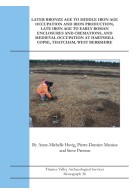Google Books previews are unavailable because you have chosen to turn off third party cookies for enhanced content. Visit our cookies page to review your cookie settings.
Iron Age and Early Roman Occupation and a Middle Iron Age Burial at Cheriton Road Sports Ground, Folkestone, Kent (Paperback)
Imprint: Thames Valley Archaeological Services
Series: TVAS Occasional Paper Series
Pages: 51
ISBN: 9781911228332
Published: 13th September 2018
Script Academic & Professional
Series: TVAS Occasional Paper Series
Pages: 51
ISBN: 9781911228332
Published: 13th September 2018
Script Academic & Professional
Usually available in 6-8 weeks.
You'll be £13.00 closer to your next £10.00 credit when you purchase Iron Age and Early Roman Occupation and a Middle Iron Age Burial at Cheriton Road Sports Ground, Folkestone, Kent. What's this?
+£4.99 UK Delivery or free UK delivery if order is over £40
(click here for international delivery rates)
Order within the next 2 hours, 11 minutes to get your order processed the next working day!
Need a currency converter? Check XE.com for live rates
(click here for international delivery rates)
Order within the next 2 hours, 11 minutes to get your order processed the next working day!
Need a currency converter? Check XE.com for live rates
This slim volume details the results of archaeological excavation in advance of development in Folkestone, on the south coast of Kent. The excavation revealed an extensive spread of occupation deposits, with some human burial, dating from the Late Bronze Age through to early Roman times. The earliest features were a single ditch and a possible cremation burial of Late Bronze Age date. The whole of the Iron Age extending into early Roman times seems to have been well represented. The Middle Iron Age dating is supported by a radiocarbon date of 365-164 cal BC. An inhumation burial associated with a second radiocarbon date of 428-353 cal BC was an unusual discovery for this period. A small collection of struck flint includes Mesolithic and possibly upper Palaeolithic material.
The bulk of the site’s activity belongs to the late Iron Age and early Roman period with the creation of ditched field systems and enclosures. A number of pits resemble grain storage pits in profile, and the faunal remains from the site suggest that the settlement was largely self sufficient with cattle being raised into maturity whilst sheep were being consumed at an earlier age, which is a fairly typical pattern for the region. No evidence of any structures was found in the excavation area but it is possible that these were located outside of the excavation area. A modest collection of pottery suggests the site was already out of use by the end of the 1st century AD.
Other titles in the series...
Other titles in Thames Valley Archaeological Services...










